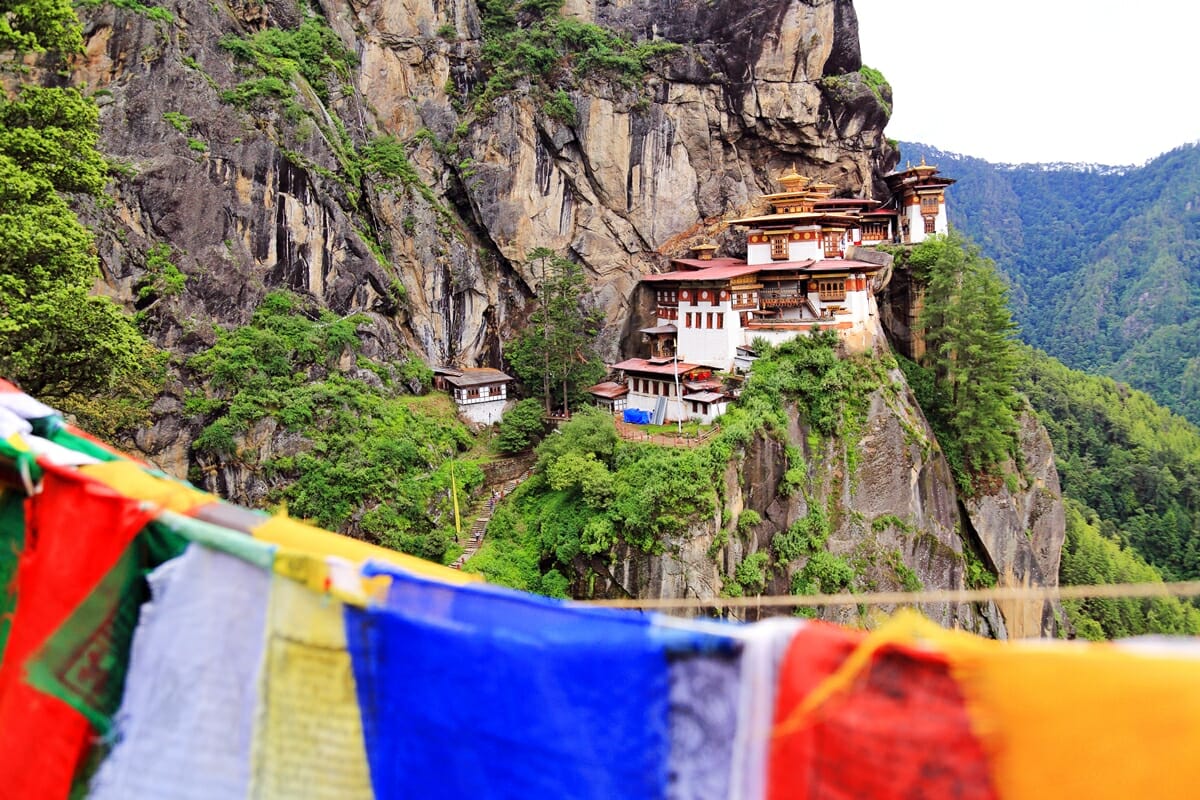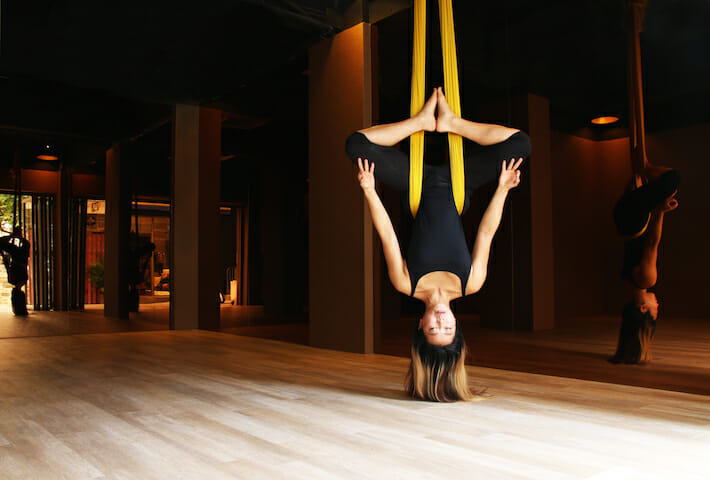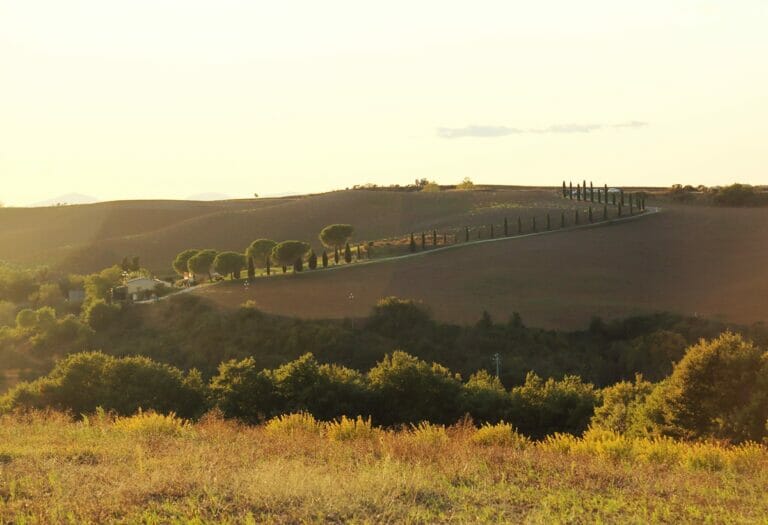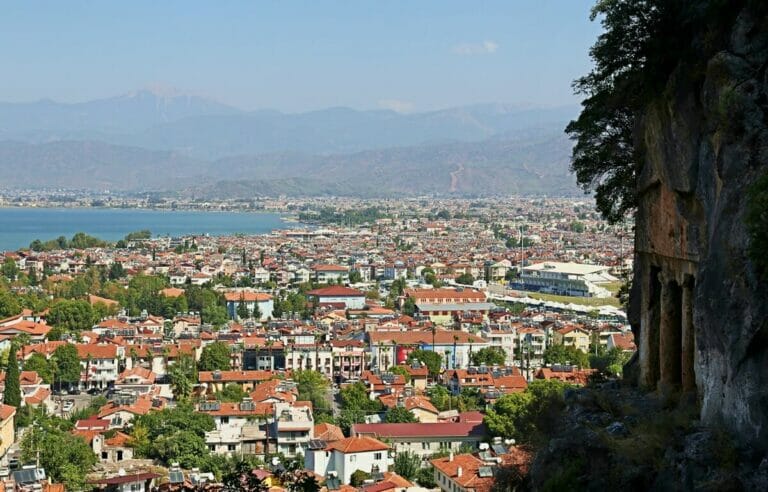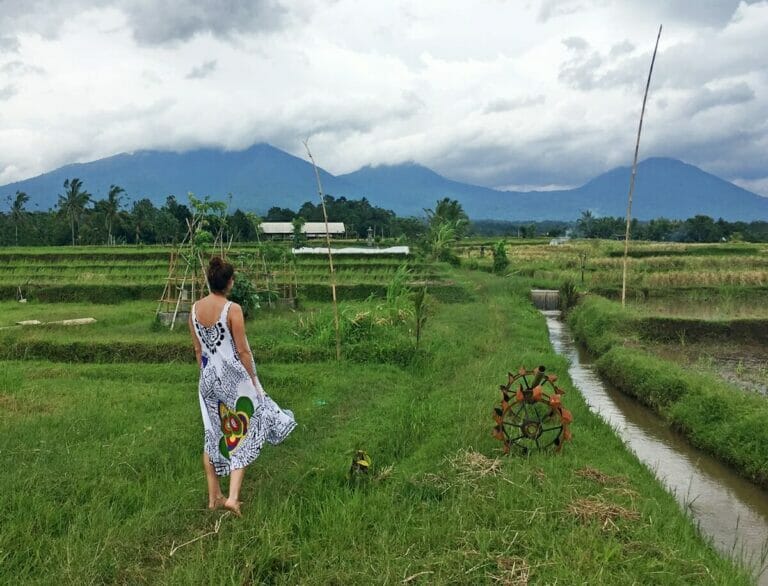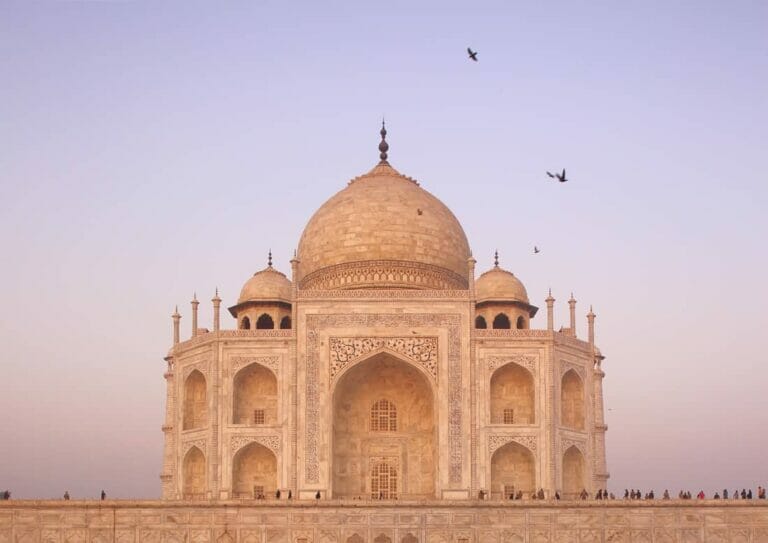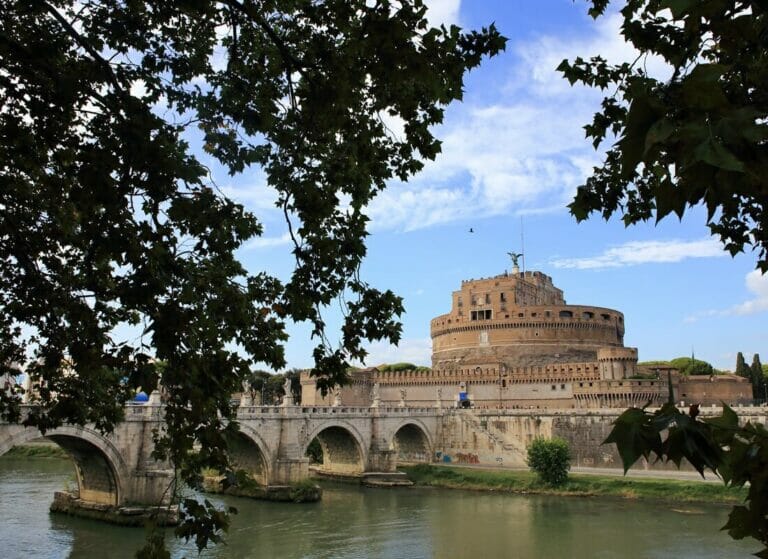Bhutan Travel Guide: Hiking to the Tiger’s Nest in Paro
The Tiger’s Nest hike is a must-do for anyone visiting Bhutan. Read on for what you need to know to visit this incredible Buddhist monastery!
I think it’s pretty safe to say that a trip to Bhutan is not complete until you hike to the Tiger’s Nest, a striking Buddhist monastery that is precariously perched on a mountain clifftop. Also known as the “Paro Taktsang Monastery”, this world-famous landmark is located just 20 minutes by car outside of Paro town and is the highlight of any Bhutan travel itinerary. The monastery is also an important pilgrimage site for Buddhists who come from far and wide to attend sacred rituals and festivals at the Tiger’s Nest.
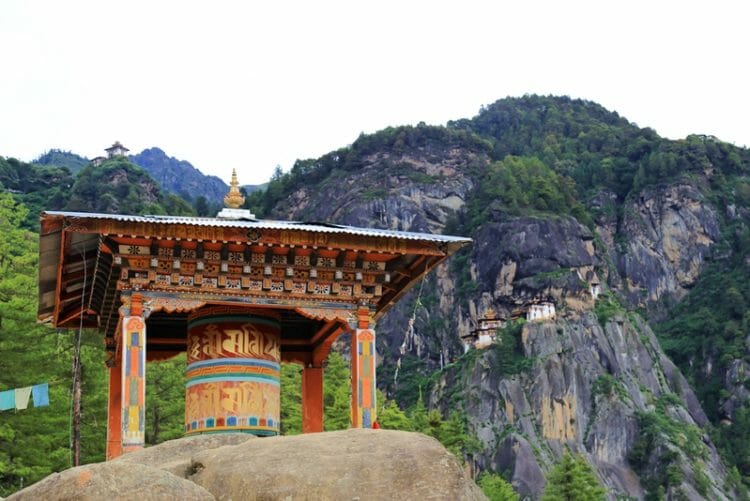
Visiting the Tiger’s Nest in Bhutan is an unforgettable experience due to its unique and remote location (it sits 3,120 meters – more than 10,000 feet – above sea level!), and the monastery is only accessible on foot via mountainous paths which makes it a journey to remember. The Tiger’s Nest hike is surrounded by beautiful forests, fluttering prayer flags and sprawling mountain ranges. Read on for everything you need to know to plan your Tiger’s Nest hike in Bhutan!
Things you need to know before you travel to Bhutan
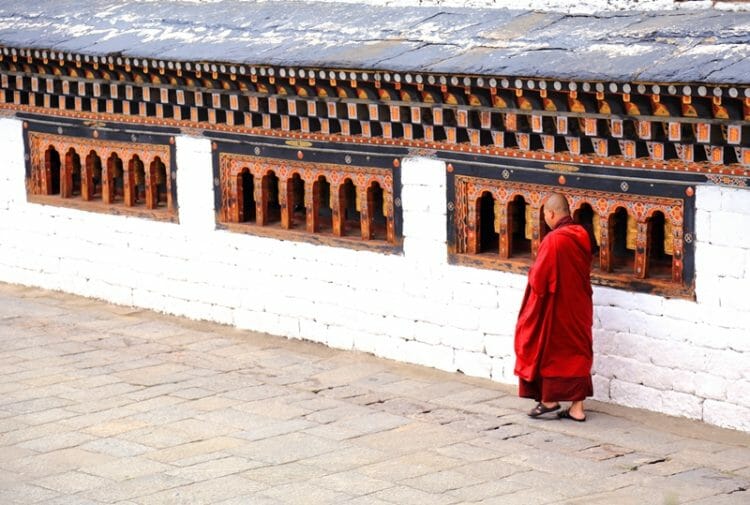
Let’s start with the basics. I cover a lot of these essential Bhutan travel tips in this article, but here’s a quick recap!
🛂 Visa requirements: All tourists (excluding Indian, Bangladeshi and Maldivian passport holders) require a visa. The visa fee is US$40.
🛬 How to get to Bhutan: The easiest and fastest way to get to Bhutan is via plane. While there are a handful of land border crossings, both Drukair (the national airlines, AKA “Royal Bhutan Airlines”) and Bhutan Airlines (privately owned) fly frequently from Kolkata, Dhaka, Kathmandu, Bangkok and Singapore to Paro International Airport (the ones in Bumthang and Gelephug are for domestic flights only). Bhutan Airlines has also announced direct flights from Hong Kong to Paro beginning January 27th 2025.
💵 Cost: “How much does it cost to visit Bhutan?” This is probably one of the most frequently asked questions about visiting Bhutan. The fee changes with number of people in your group and which part of the country you are visiting. You can expect to pay approximately US$300-400 per person per day if you are traveling in a group of 3+ people, and solo travelers will likely pay upwards of US$400-480 per person per day. This is inclusive of the country’s “Sustainable Development Fee” of US$100 per day (down from US$200 as of September 2023), a standard hotel, tour guide, transportation and meals. This however does not include tips, air fare and any additional spending.
🚗 Tour company: Because the price of travel packages (hotels, drivers, guides) are fairly standardized in Bhutan, it is not a very useful comparison tool. What it really comes down to is professionalism, experience, reliability and ability to customize your itinerary and hotel preferences.
We ended up planning our trip to Bhutan with Druk Asia, a Bhutanese tour company that has been in operation for more than a decade. Our guide, Nawang, was experienced, patient, dedicated and knew about everything there is to know about Bhutan. Druk Asia’s guides climb the Tiger’s Nest trail almost on a weekly basis so know the various paths like the back of their hands.
Interested in booking a trip to Bhutan? As of June 2022 it is technically no longer mandatory to book a Bhutan tour via a tour agency…however, I highly recommend booking with Druk Asia for a fuss-free trip to Bhutan. They organize your visa, transportation (public transportation options are extremely limited and self-driving is not recommended), qualified and experienced guide, hotel accommodation and itinerary – click here to get in touch and see package details!
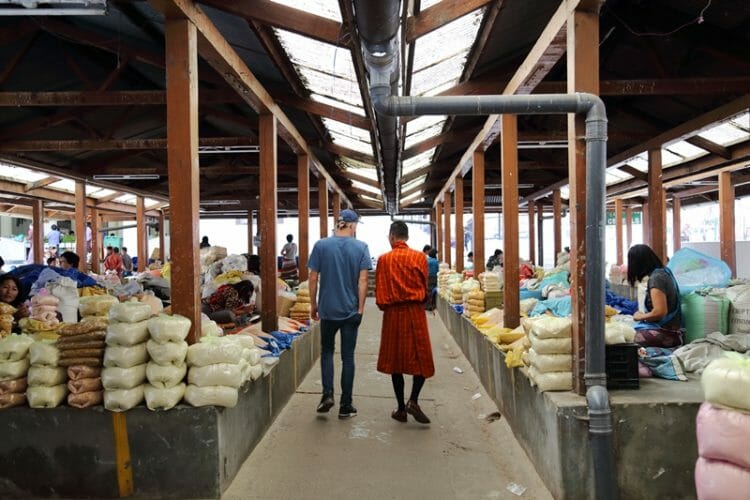
Related: The most breathtaking places you must visit if you only have 1 week in Bhutan
☀️ Best time to visit: The short answer is, it depends on what you want to see. The peak season for travel to Bhutan is from March to May and September to November – Bhutan in spring is a sight to behold with flowers blossoming everywhere, and autumn is festival season. During spring and autumn, the days are cooler which makes them ideal seasons for trekking in Bhutan.
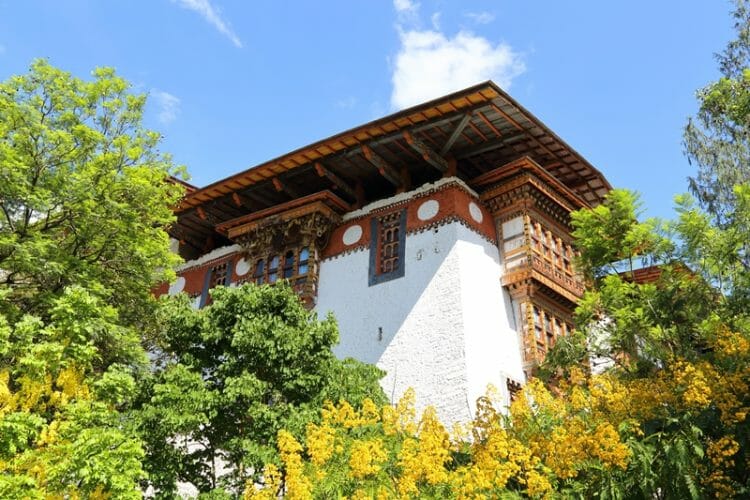
The off-peak season for travel to Bhutan is from December to February and June to August. During the winter months, you can try to spot the black-necked crane, check out the special winter festivals or go snow trekking in Bhutan. The summer months are warm and the country is filled with blue skies and sunny days, though you can expect some light rainfall.
You can trek to the Tiger’s Nest regardless of which season you travel to Bhutan in, even in the snow. You may want to avoid extremely rainy days as the path becomes very muddy and slippery.
👚 Currency: Bhutanese currency is known as the Ngultrum, or the Nu for short. It is pegged to the Indian Rupee, so some places also accept small denomination INR notes. Otherwise, you can exchange money at banks or local shops – the rate is approximately US$1 to 85 Nu or 1 Euro to 90 Nu. There are ATMs in Bhutan, but only in the main towns, and they don’t always work. Visa is accepted at most hotels and bigger shops, but Mastercard/American Express are not accepted.
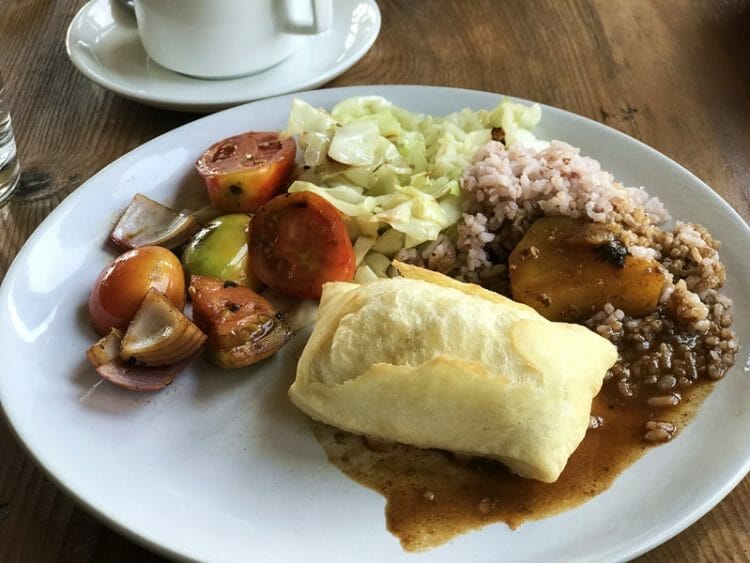
🍽️ Food: There is tons of fresh produce in Bhutan and Bhutanese cuisine is influenced by Chinese, Tibetan and Indian food. The restaurants you are taken to will mostly serve buffet-style meals with plenty of options – white or red rice, vegetables, pork and chicken, and food tends to be seasoned well and not too spicy.
Read more: Click here for everything you need to know to plan your trip to Bhutan!
History of the Tiger’s Nest Monastery
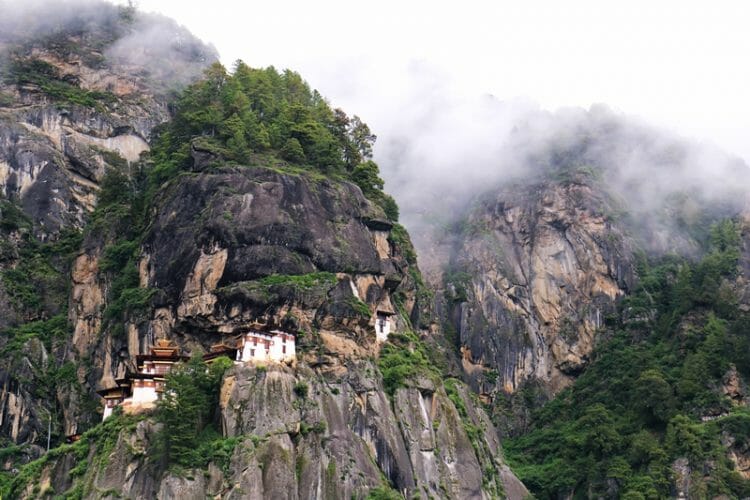
Tiger’s Nest, or Paro Taktsang, was first built in the 17th century and it is believed to be where the second Buddha, Guru Rinpoche, flew to on the back of a flying tigress (a manifestation of one of his consorts). He meditated in one of the caves for three years, three months, three weeks, three days and three hours. Others say that it is called the Tiger’s Nest because tigers had been sighted in the caves deep within the mountain. These caves have been visited by monks from the 8th century onward.
In 1998, the Paro Taktsang was almost completely devastated by a fire before being restored in 2005. Today, the complex has its iconic white brick facade with red and golden roofs back. It consists of 4 main temples as well as several other shrines, caves, dwellings and a butter lamp room, all interconnected by staircases carved into the rock or made out of planks of wood. Inside the complex, monks wander around carrying out their daily tasks, meditating, chanting and reading scripture.
Best season to hike to the Tiger’s Nest
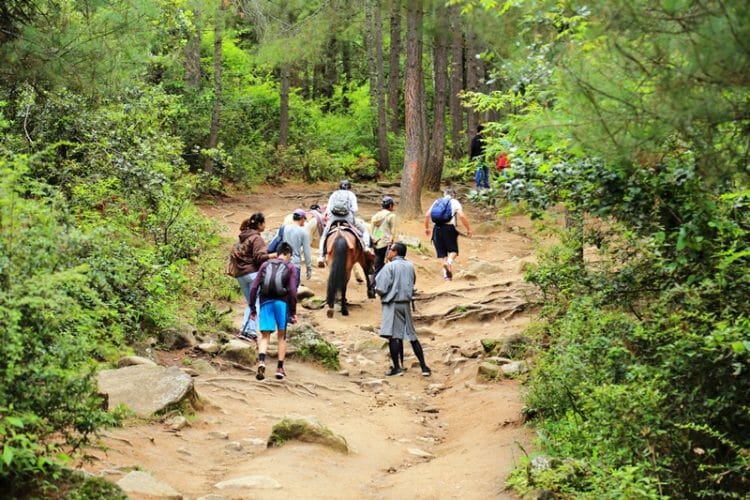
The weather across Bhutan varies depending on elevation. In Paro, the temperature ranges from -1 to 13 Celsius (30 to 55 Fahrenheit) from December to February, 0 to 23 Celsius (32 to 73 Fahrenheit) from March to May, 14 to 26 Celsius (57 to 79 Fahrenheit) from June to August and 1 to 23 Celsius (34 to 73 Fahrenheit) from September to November. The further up you go along the trail to the Tiger’s Nest, the cooler the air becomes.
Most people will recommend that you do the Tiger’s Nest hike in Bhutan in spring or autumn (peak season), when the weather is less oppressive. Though many people avoid Bhutan during the summer “monsoon season”, we hiked to the Tiger’s Nest in July and experienced nothing more than a faint drizzle which was perfect and helped us cool off.
The trail also stayed nice and dry. Hiking to the Tiger’s Nest in winter can also be a unique experience, as you get to see the iconic monastery covered in a sheet of white snow, though it will be quite chilly during this season.
Read more: Need more travel inspiration? Here are some travel photos of Bhutan to stoke your wanderlust!
What to wear for the Tiger’s Nest trek and what to bring
Hiking to the Tiger’s Nest in Bhutan will take you anywhere from 5 to 7 hours on an uneven trail, so you’re going to want to wear a good pair of trainers or hiking boots, comfortable walking pants or shorts (chaffing cream if you need it) and an exercise top or t-shirt. There is shade along some parts of the trail to the Tiger’s Nest, but you should bring some sunscreen and a cap along for warmer days.
A collapsible hiking pole is helpful if you happen to have one in your arsenal, otherwise you can rent one at the foot of the trail. Alternatively, an umbrella works just as well!
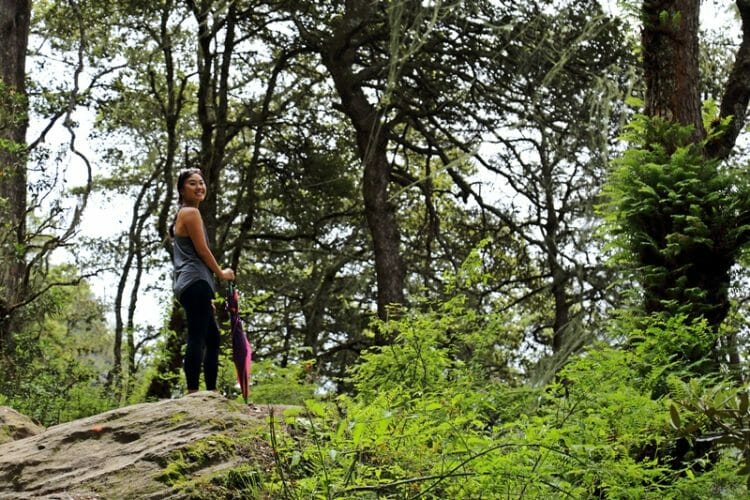
Make sure you bring a bottle of water – bonus points if you have your own reusable water bottle. If you can, bring a snack or granola bar as you might not get back down until 2 or 3 PM. There is a small cafeteria midway where you can stop for a cup of tea and a bathroom break, and there is toilet paper as well as hand soap though you might still want to bring along a packet of tissues just in case.
Once you finally reach the Tiger’s Nest monastery, you will need to put all of your personal belongings away in a locker as you’re not allowed to bring bags, cameras or phones into the complex. You also need to abide by the dress code and will need to cover your legs and wear a long-sleeved top, so bring along a sweater and/or pants that you can change into if you’re hiking in shorts. The monastery accepts donations, so you can bring some cash if you’d like to make a contribution.
How to get to the Tiger’s Nest trail
The trail starts about 15-20 minutes outside of Paro Town. The best way to get here is by car.
How to reach the Tiger’s Nest monastery
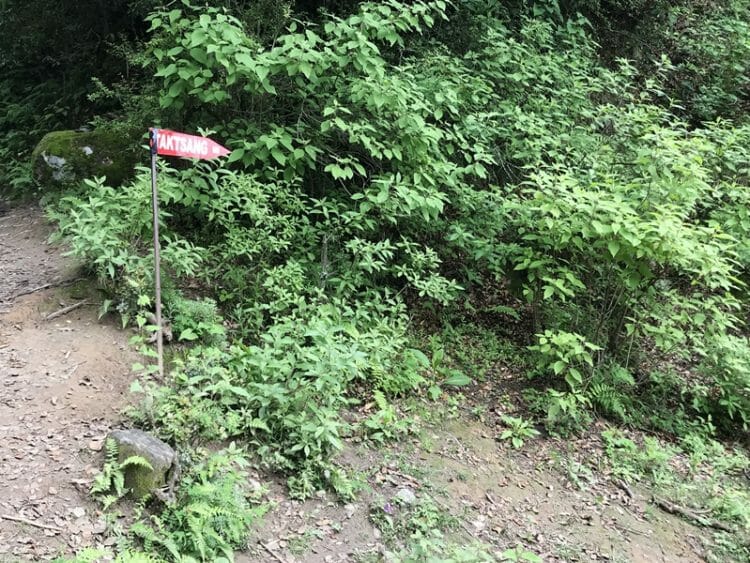
Though you could ride a pony to the cafeteria at the midway point (where you can see the monastery from afar), I wouldn’t recommend it for a number of reasons. Not only is it thought that riding a pony part of the way can lead to bad karma, not all the ponies and horses are fed/treated well, and they can’t take you the entire length of the trail anyway.
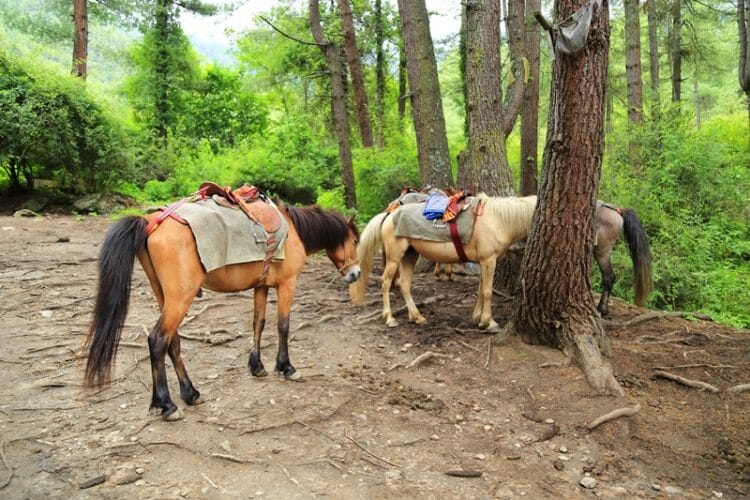
You can’t get out of hiking if you want to reach the actual monastery, but guess what? Hiking to the Tiger’s Nest is part of the experience, and though I am not an avid hiker I truly believe that I wouldn’t have appreciated or enjoyed visiting the Tiger’s Nest as much as I did had we gotten there some other way.
I overheard a woman on the path say to her guide, “you guys really need to build a cable car so people don’t have to trek.” I beg to differ.
The total length of the hike to the Tiger’s Nest is approximately 8.6 KM or 5.3 miles (4.3 KM or 2.6 miles each way), and will take you anywhere from 5-7 hours (approx 3-4 hours to get to the monastery, and 2-3 hours to get back down). Start the hike at 9 AM to get back into town for a late lunch.
Hiking to the Tiger’s Nest in Bhutan is moderately challenging, especially if you haven’t hiked much in the past, but trekking in Bhutan is an incredible experience not to be missed. Take it slow. We saw children as young as 6 or 7 on the trail with us, and people in their 60s and 70s as well. It’s not impossible, you just have to pace yourself even if it takes you closer to 7 hours to finish the round trip trek to the Tiger’s Nest.
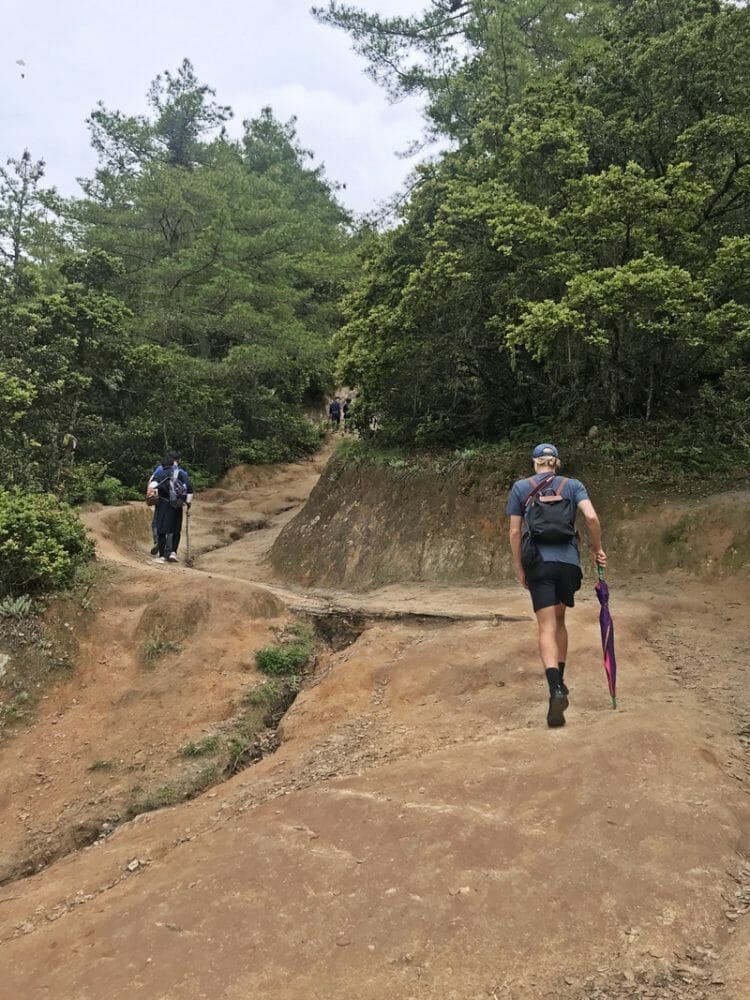
The hike to the Tiger’s Nest monastery starts off mostly uphill along an uneven trail for about an hour or so. You gain elevation quickly and make your way along switchback after switchback, so it’s best to start slow to get your body warmed up. You’ve got to pace yourself to make the 900 meter vertical ascent!
Though I practice Yoga and controlled breathing techniques, I don’t hike frequently and found myself wanting to give up after just 30 minutes of the hike – I had peaked too early trying to keep up with my bloody gazelle of a boyfriend.
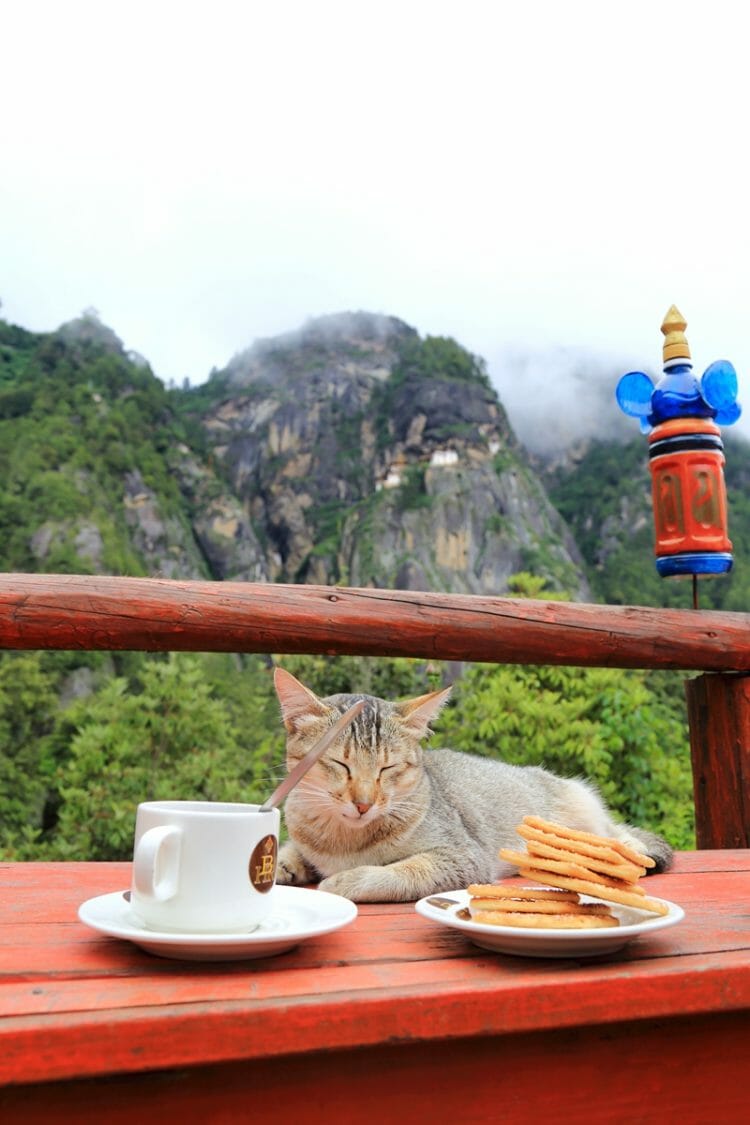
When we finally arrived at the cafeteria, I quickly plopped myself down to catch my breath, re-hydrate and hang out with this cool cat. After a hot cuppa and toilet break, we started on the trail again which flattens out slightly, though not by much. Another hour or so later, you reach the same elevation as the Tiger’s Nest monastery itself, and start to make your way across the mountain.
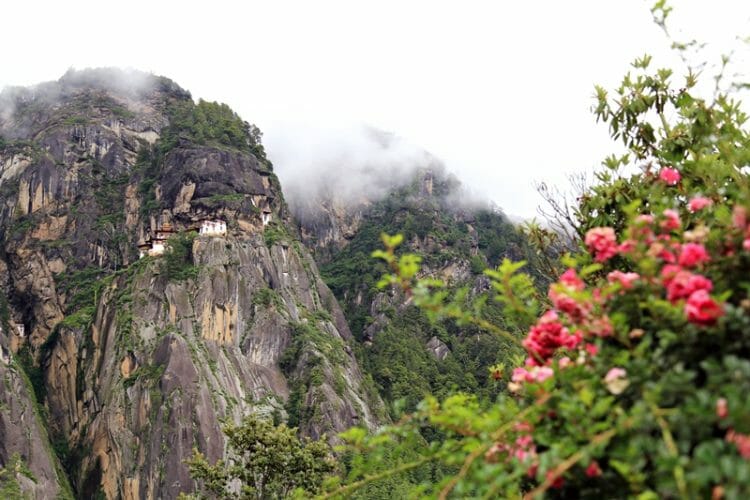
But not for long, because this is where the dreaded hundreds of stairs start to lead you up and down for the remaining portion of the hike.
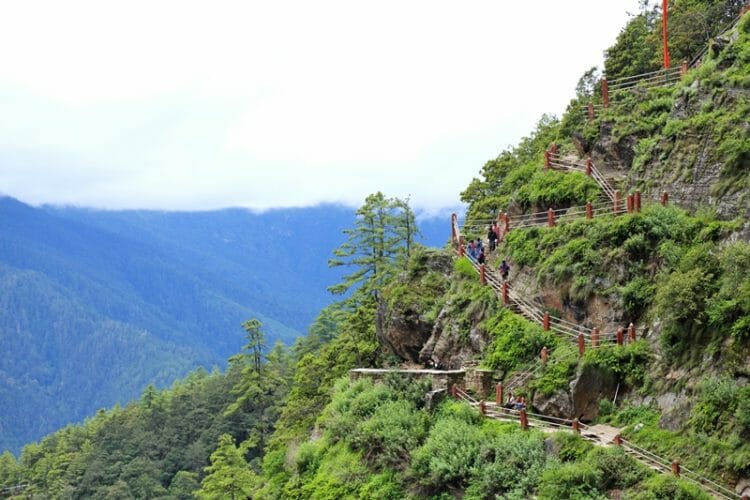
But the good news is, there is view point after view point and photo opp after photo opp along this last leg, so stop frequently for your picture perfect shot! The Buddhist monastery is stunning from every single angle.
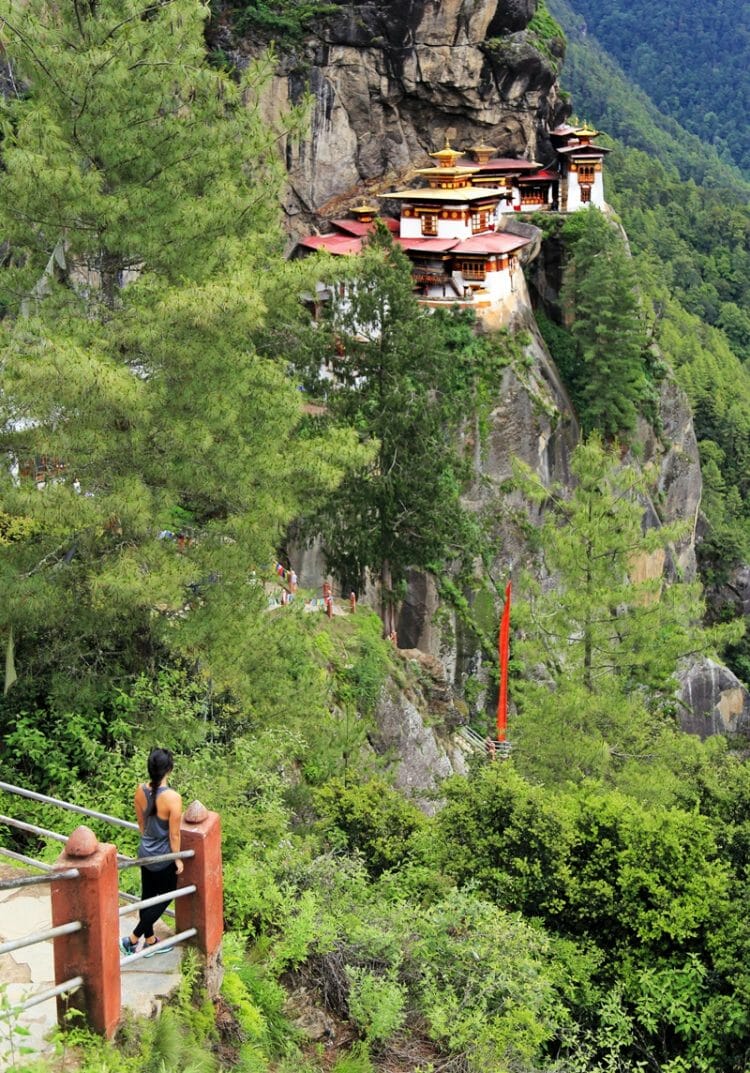
Once you cross the bridge and waterfall, you’re 99% of the way there. When you arrive at the monastery itself, put your bag, phone and camera into the designated lockers and make your way into the complex to explore its various shrines and caves.
The interior spaces are adorned with gilded statues, paintings and scrolls of deities and the second Buddha, along with ritual cakes, bowls of saffron water and buckets full of local snacks and chocolates as gifts from Buddhist devotees. You’ll have to take your shoes off when you enter these rooms, and be careful not to step on cloth used to wrap up the scrolls.
Though I enjoyed the hike (you can quote me on that) and loved visiting the interior of the Tiger’s Nest complex, what made the experience truly memorable for me was spending time with this group of young monks. While getting ready to make our way into the complex, we watched curiously as they took turns flipping coins into a dug-up hole in the dirt and laughing.
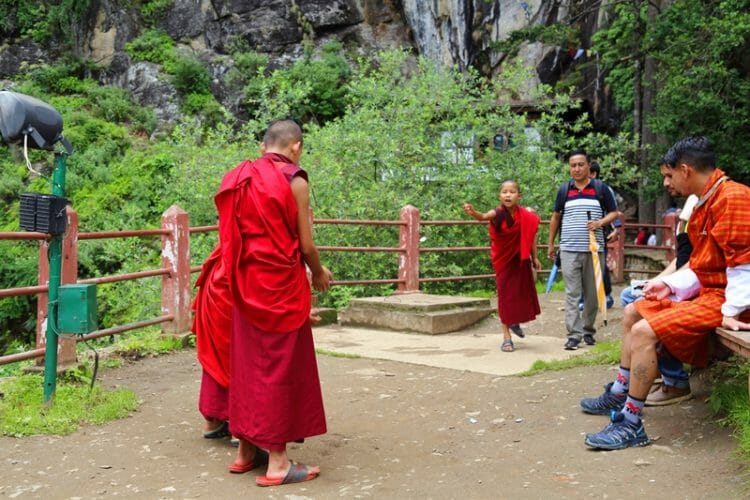
When I started stretching my hamstrings, they looked over and started doing forward folds of their own. When I stretched my quadriceps, they giggled and did they same. Next thing we knew, they were speaking to an older monk – all I could understand was bits and pieces (the word, “Yoga” was in there a few times) as they re-enacted my forward fold and standing balancing stretch to their elder.
The older monk spoke some English and asked where we were from, where we had traveled to in Bhutan, and I asked the boys how old they were. The older monk told me that the younger one was 6 (“7!” protested the little monk), and his buddy was 9.
After we visited the last cave, the boys approached our guide, “Uncle, uncle!” they said. They wanted to play the coin toss game outside! We followed them, and learned how to flip coins into the holes – it is MUCH harder than it looks! We spent another 45 minutes or so just tossing coins into a hole, and more and more people (including the security guards) joined in to play.
The game was only called off after one of the senior monks called everyone inside to complete their rituals. It was so refreshing to watch children be just that – children. No iPads, no TVs, just a few pals chumming around outside, breathing in fresh air.
Photography gear for the Tiger’s Nest
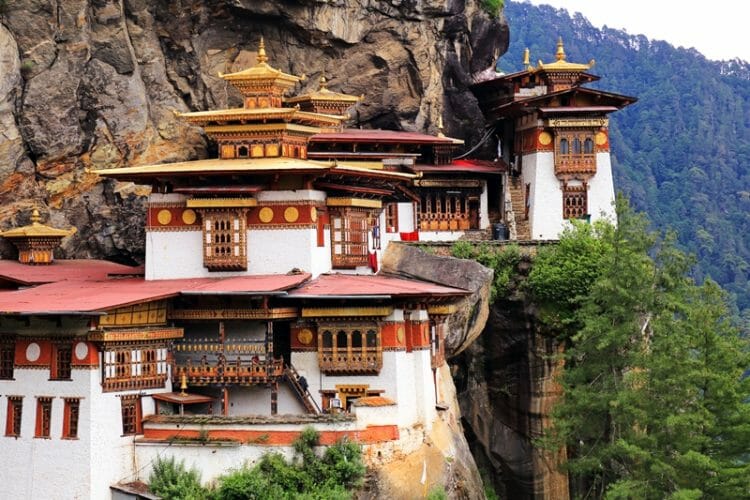
Photography is not allowed in the Tiger’s Nest complex, but there are plenty of photo opportunities along the path. I bought my 24-105 mm lens which was perfect for landscape shots as well as zoomed-in shots of the monastery itself, though I also took many photos using my iPhone. You can expect some backlight in your shots of the monastery, though it can be fixed in post-processing. Here are some top tips for taking photos with your smartphone, and some of my favorite photo editing tools.
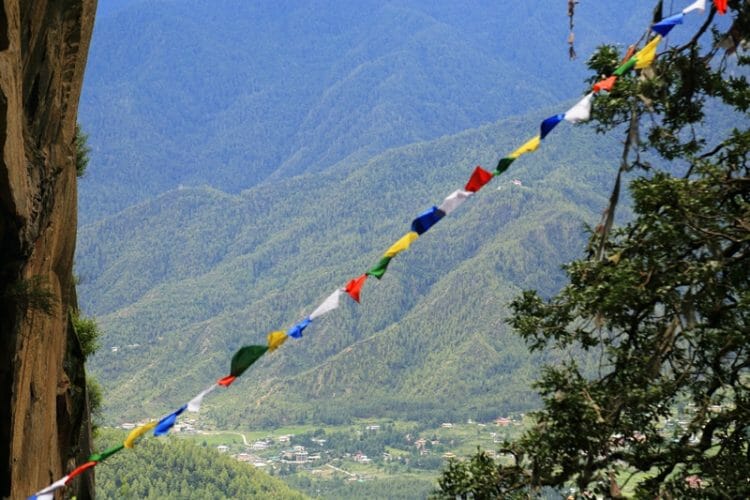
Hiking to Paro Taktsang is a once-in-a-lifetime experience that shouldn’t be left off your Bhutan travel itinerary. Leave a comment below and let me know if this is on your bucket list!
Ready for a trip of a lifetime? I highly recommend booking with Druk Asia for a fuss-free trip to Bhutan – click here to get in touch and see package details!
Planning a Bhutan trip? You might also find these guides helpful:
- Get started with your travel planning with everything you need to know before visiting Bhutan
- And make sure you check out this 1 week Bhutan itinerary
- Not convinced yet? Then you might want to take a look at these stunning Bhutan travel photos
Pin this for later!
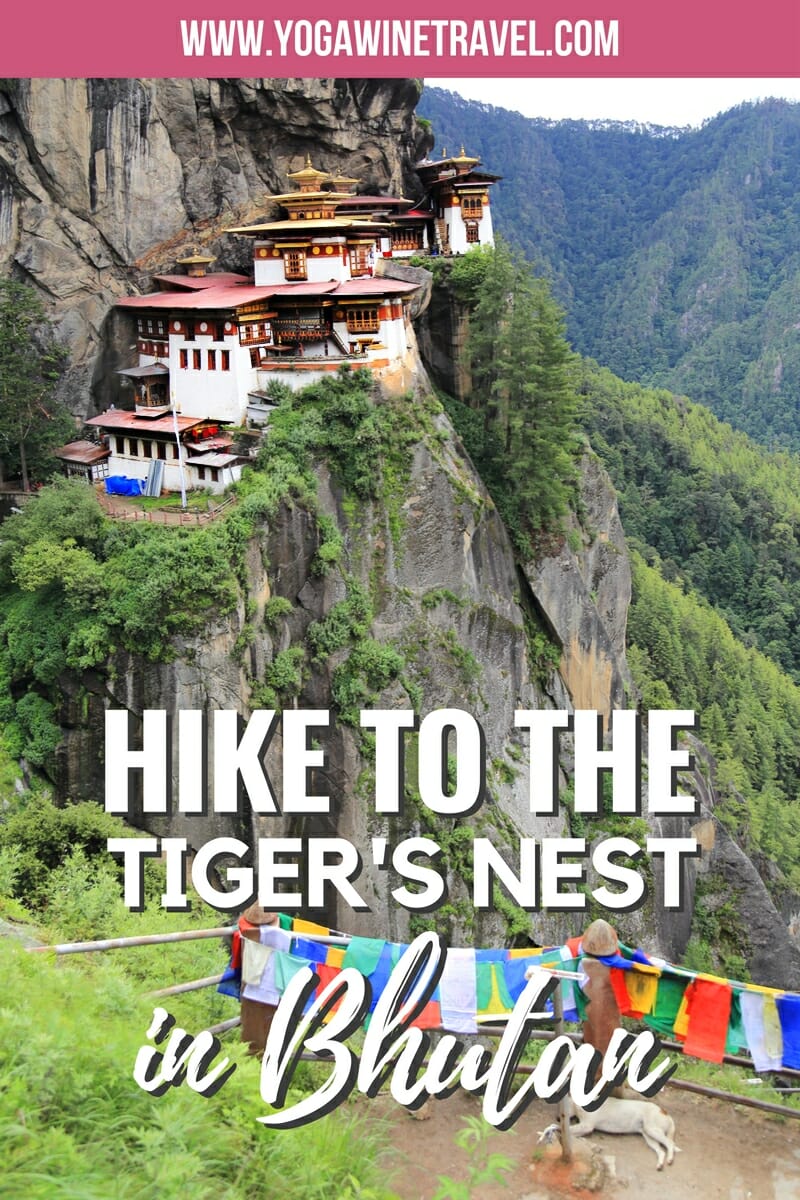
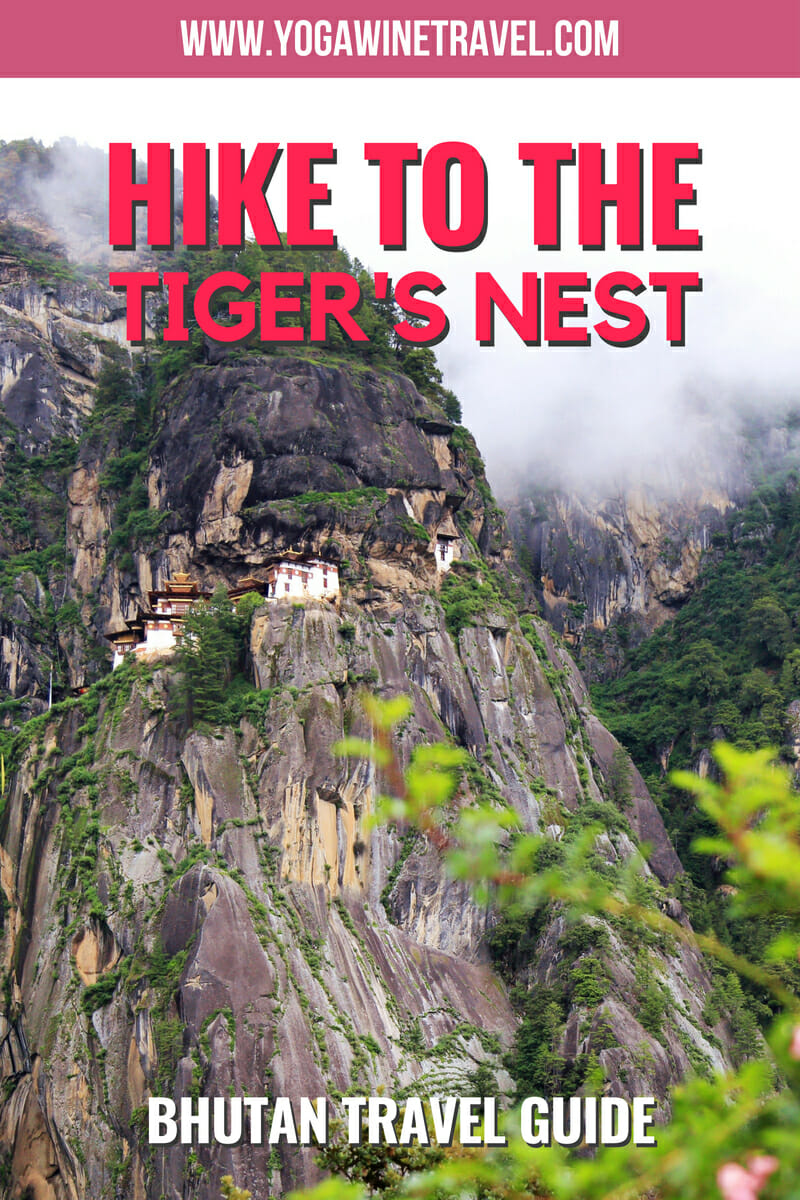
My trip to Bhutan was in collaboration with Druk Asia. I only recommend products, services and hotels that I have had positive personal experiences with – the opinions on Yogawinetravel.com are (and always will be) my own!
This article contains affiliate links. If you choose to book using these links, I will earn a small commission at no extra cost to you. Thank you for supporting my website by using these links.
Video music credit: Chris Haugen – Fresh Fallen Snow / Youtube Audio Library
Enjoyed reading this article? Subscribe to the mailing list!
* Unsubscribe at any time. Your e-mail address will only ever be used to send the occasional Yoga, Wine & Travel newsletter.

